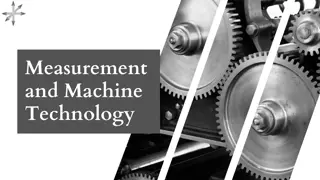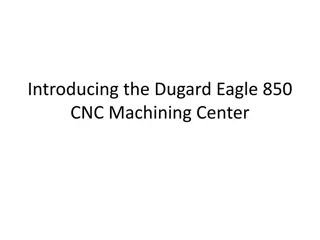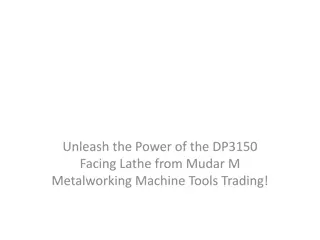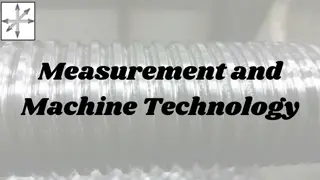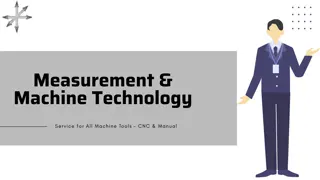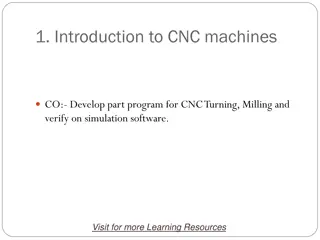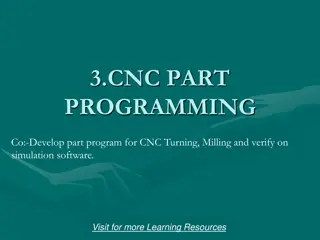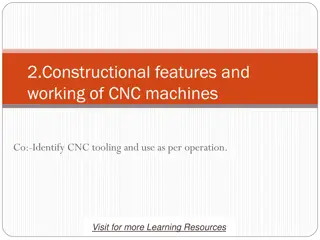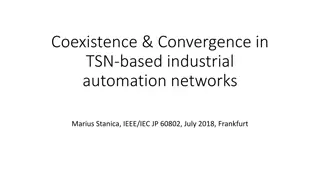Understanding CNC Machine Tools: Fundamentals and Advantages
Unveil the essentials of CNC machine tools, from its definition to major features, classifications, components, and advantages over conventional machine tools. Explore how CNC technology enhances precision, flexibility, production rates, and quality while reducing costs and lead time.
Download Presentation

Please find below an Image/Link to download the presentation.
The content on the website is provided AS IS for your information and personal use only. It may not be sold, licensed, or shared on other websites without obtaining consent from the author. Download presentation by click this link. If you encounter any issues during the download, it is possible that the publisher has removed the file from their server.
E N D
Presentation Transcript
Part #3 CNC Machine Tools
Outline: Introduction - CNC definition Major features of CNC M/c tools Classifications of CNC M/c tools Major components of CNC system
1. Fundamentals of CNC M/C Tools 1.1. Computer Numerical Control (CNC) Defn. CNC is the process of manufacturing machined parts. This process is controlled by a computerized controller called Machine Control Unit (MCU). The MCUgenerates, stores and processes CNC programs. The MCU uses motors to drive each axis of a machine and regulates its direction, speed, and the amount of time each motor rotates.
Contd CNC can also be defined as a programmable automation in which the mechanical actions of a machine tool are controlled by a program containing coded alphanumeric data that represents relative positions between a work head (e.g., cutting tool) and a work part. Fig. 1. CNC System
1.2. Major Features of CNC Machine Tools Storage of more than one part program Various forms of program input Program editing at the machine tool Fixed cycles and programming subroutines Interpolation Cutter length & size compensations Acceleration and deceleration computations Communications interface Diagnostics
1.3. When it is appropriate to use NC/CNC system? 1) Parts from similar raw materials, in a variety of sizes and /or complex shapes. 2) Low to medium part production. 3) Similar processing operations and sequences among work pieces. 4) Meet tight tolerance & accuracy requirements compared to similar conventional machines.
1.4. Advantages of CNC over conventional Machine Tools > Flexibility with accuracy & repeatability, reduced scraps, high production rates, good quality > Reduced tooling costs > Easy machine adjustments >More operations per set up > Less lead time > Accommodate design changes > Less skilled operator
1.5. What is DNC? Direct numerical control (DNC) control of multiple machine tools by a single (mainframe) computer through direct connection and in real time. Central computer stores programs & directs NC operations; NC m/cs are dependent on central computer. 1960s technology two way communication Distributed numerical control (DNC) network consisting of central computer connected to machine tool MCUs, which are CNC. Central computer stores the program & distribute it to the CNC machines. present technology two way communication
Contd Fig. DNC System
2. Classification of CNC Machine Tools 1. Based on Motion Type i. Point to point systems Require the cutter and the work piece to be placed at a certain fixed relative positions at which they must remain while the cutter does its work. Each axis is driven separately. Dimensional information that must be given to the machine tool will be a series of required position of the two slides. Servo systems can be used to move the slides and no attempt is made to move the slide until the cutter has been retracted back. Examples are drilling, boring and tapping machines etc.
Contd ii. Contouring systems (Continuous path systems) Involves motion of work piece with respect to the cutter while cutting operation is taking place. Contouring machines can also be used as point-to-point machines, but it will be uneconomical to use them unless the work piece also requires having a contouring operation to be performed on it.
Contd. These machines require simultaneous control of axes. Relative positions of the work piece and the tool should be continuously controlled. The control system must be able to accept information regarding velocities and positions of the machines slides and feed rates should be programmed. Examples are milling, routing machines etc.
2. Based on the Control loops 1. Open loop systems Programmed instructions are fed into the controller through an input device. These instructions are then converted to electrical pulses (signals) by the controller and sent to the servo amplifier to energize the servo motors. If the system performance is affected by load, temperature, humidity, or lubrication then the actual output could deviate from the desired output. Generally the open - loop system is used in point-to-point systems where the accuracy requirements are not critical.
Contd. 2.2. Closed loop systems The closed-loop system has a feedback subsystem to monitor the actual output and correct any discrepancy from the programmed input. These systems use position and velocity feedback and the feedback system could be either analog or digital. The analog systems measure the variation of physical variables such as position and velocity in terms of voltage levels. Digital systems monitor output variations by means of electrical pulses. To control the dynamic behavior and the final position of the machine slides, a variety of position transducers are employed.
Contd. If a discrepancy is revealed between where the machine element should be and where it actually is, the sensing device signals the driving unit to make an adjustment, bringing the movable component to the required location.
3. Based on the number of axes a) 2 & 3 Axes CNC machines CNC lathes will be coming under 2 axes machines. There will be two axes along which motion takes place. The saddle will be moving longitudinally on the bed (Z-axis) and the cross slide moves transversely on the saddle (along X-axis). In 3-axes machines, there will be one more axis, perpendicular to the above two axes. Ex. CNC milling machine b) 4 & 5 axes CNC machines A 5-axis milling centre includes the three X, Y, Z axes, the A axis which is rotary tilting of the spindle and the B-axis, which can be a rotary index table.
Contd. Reduced cycle time by machining complex components using a single setup. In addition to time savings, improved accuracy can also be achieved as positioning errors between setups are eliminated. Improved surface finish and tool life by tilting the tool to maintain optimum tool to part contact all the times. Higher axes machining has been widely used for machining sculptures surfaces in aerospace and automobile industry.
4. Based on the Power Supply 1. Mechanical systems Mechanical power unit refers to a device which transforms some form of energy to mechanical power which may be used for driving slides, saddles or gantries forming a part of machine tool. 2. Electric systems Electric motors may be used for controlling both positioning and contouring machines. They may be either a.c. or d.c. motor and the torque and direction of rotation need to be controlled. The speed of a d.c. motor can be controlled by varying either the field or the armature supply. 3. Hydraulic systems These hydraulic systems may be used with positioning and contouring machine tools of all sizes. These systems may be either in the form of rams or motors. Hydraulic motors are smaller than electric motors of equivalent power.
3. MAJOR COMPONENTS OF A CNC SYSTEM 1. Different components related to CNC machine tools 1.1. Part program A part program is a series of coded instructions required to produce a part. It controls the movement of the machine tool and on/off control of auxiliary functions such as spindle rotation and coolant. The coded instructions are composed of letters, numbers and symbols. 1.2. Program input device The program input device is the means for part program to be entered into the CNC control. Commonly used program input devices are punch tape reader, magnetic tape reader, floppy diskettes and computer via RS-232-C communication.
Contd. 1.3. Machine Control Unit MCU is the heart of a CNC system. It is used to perform the following functions: To read the coded instructions. To decode the coded instructions. To implement interpolations (linear, circular, and helical) to generate axis motion commands. To feed the axis motion commands to the amplifier circuits for driving the axis mechanisms. To receive the feedback signals of position and speed for each drive axis. To implement auxiliary control functions such as coolant or spindle on/off and tool change.
Contd. 1.4. Drive System A drive system consists of amplifier circuits, drive motors, and ball lead-screws. The MCU feeds the control signals (position and speed) of each axis to the amplifier circuits. The control signals are augmented to actuate drive motors which in turn rotate the ball lead-screws to position the machine table. 1.5. Machine Tool CNC controls are used to control various types of machine tools. Regardless of which type of machine tool is controlled, it always has a slide table and a spindle to control of position and speed. The machine table is controlled in the X and Y axes, while the spindle runs along the Z axis.
Contd. 1.6. Feed Back System It uses position and speed transducers to continuously monitor the position at which the cutting tool is located at any particular instant. The MCU uses the difference between reference signals and feedback signals to generate the control signals for correcting position and speed errors.
2: Machine axes designation Machine axes are designated according to the "right-hand rule", When the thumb of right hand points in the direction of the positive X axis, the index finger points toward the positive Y axis, and the middle finger toward the positive Z axis.
Axes configuration: X axis moves from right to left as you face the machine. Y axis move toward and away from you. The Z axes is the spindle movement up and down spindle . A move toward work is Z. A move away from work is + Z.
5. CNC SYSTEMS - Electrical Components 1. Power units In machine tools, power is generally required for For driving the main spindle For driving the saddles and carriages For providing power for some ancillary units. The motors used for CNC system are of two kinds: Electrical - AC , DC or Stepper motors Fluid - Hydraulic or Pneumatic Stepper motors and servo motors are the popular choices in linear motion machinery due to their accuracy and controllability. They exhibit favorable torque-speed characteristics and are relatively inexpensive.
Contd. 2. Encoders An encoder is a device used to change a signal or data into a code. These encoders are used in metrology instruments and high precision machining tools ranging from digital calipers to CNC machine tools. They are 3 in type: Linear encoders Rotary encoders Positional encoders 3. CNC Controller There are two types of CNC controllers, namely closed loop and open loop controllers. They created an open platform that could easily communicate with other devices over commercially available MS Windows operating system, while maintaining the performance and reliability of the CNC machine tool.
i. Open Loop : No feedback signal to axis drive motors. Utilizes stepper motors. ii. Closed Loop: Incorporates a position and velocity feedback link to machine control unit. Transducer, resolver, and/or tachometer attached to machine tool slide.
6. CNC SYSTEMS - Mechanical Components The drive units of the carriages in NC machine tools are generally the screw & the nut mechanism. There are different types of screws and nuts used on NC machine tools which provide low wear, higher efficiency, low friction and better reliability. 1. Recirculating ball screw The recirculating ball screw assembly shown has the flanged nut attached to the moving chamber and the screw to the fixed casting. Thus the moving member will move during rotational movement of the screw. In these types of screws, balls rotate between the screw and nut and convert the sliding friction (as in conventional nut & screw) to the rolling friction. As a consequence wear will be reduced and reliability of the system will be increased.
The traditional ASME thread used in conventional machine tool has efficiency ranging from 20% to 30% whereas the efficiency of ball screws may reach up to 90%.
Contd. There are two types of ball screws. In the first type, balls are returned through an external tube after few threads. In another type, the balls are returned to the start through a channel inside the nut after only one thread. These ball screws have the problem that minimum diameter of the ball (60 to 70% of the lead screw) must be used, limiting the rate of movement of the screw. 2. Roller screw These types of screws provide backlash-free movement and their efficiency is same as that of ball screws. These are capable of providing more accurate position control. The thread form is triangular with an included angle of 90 degrees.
Contd. >The thread form is triangular with an included angle of 90 degrees. > There are two types of roller screws: planetary and recirculating screws.
Contd. 7. CNC Tooling i. Tool changing arrangements There are two types of tool changing arrangements: manual and automatic. ii. Tool turrets An advantage of using tool turrets is that the time taken for tool changing will be only the time taken for indexing the turret. Only limited number of tools can be held in the turret.
Contd. iii. Tool magazines Tool magazines are generally found on drilling and milling machines. A larger tool magazine can accommodate more number of tools, but the power required to move the tool magazine will be more. Hence, a magazine with optimum number of tool holders must be used. The following types of tool magazines exist: circular, chain and box type.
Contd. a. Chain magazine These magazines can hold large number of tools and may hold even up to 100 tools. In these chain magazines, tools will be identified either by their location in the tool holder or by means of some coding on the tool holder. The positioning of the magazine for the next tool transfer will take place during the machining operation.
Contd. b. Circular magazine The tools are arranged in a circular pattern and they will hold about 30 tools. Geneva mechanism is used for changing the tools. c. Box magazine In these magazines, the tools are stored in open ended compartments. The tool holder must be removed from the spindle before loading the new tool holder. The spindle should move to the tool storage location rather than the tool to the spindle. Hence, more time will be consumed in tool changing.
Contd. 3. Automatic tool changers Whenever controller encounters a tool change code, a signal will be sent to the control unit so that the appropriate tool holder in the magazine comes to the transfer position. The tool holder will then be transferred from the tool magazine to the spindle nose. This can be done by various mechanisms. One such mechanism is a rotating arm mechanism.










